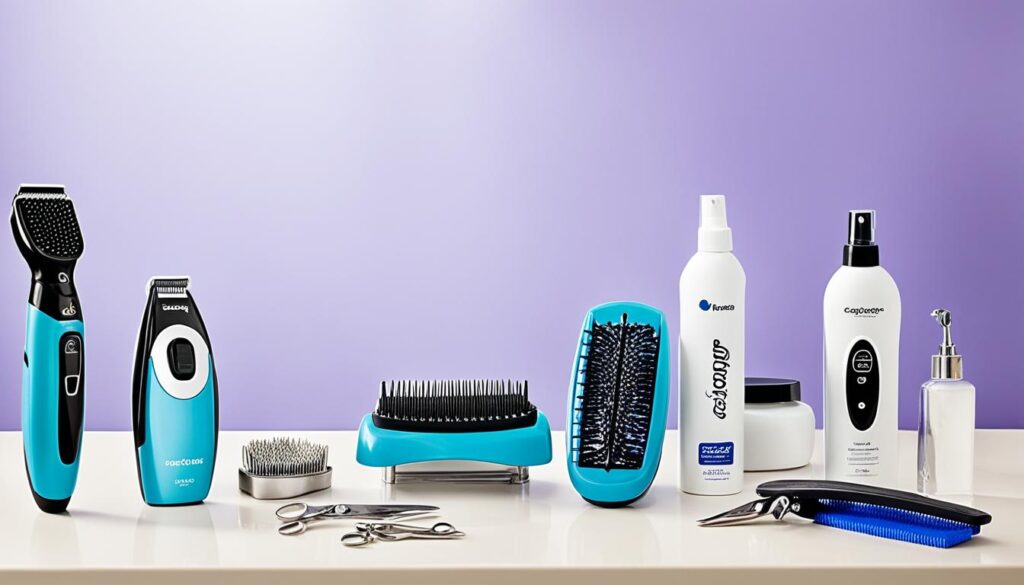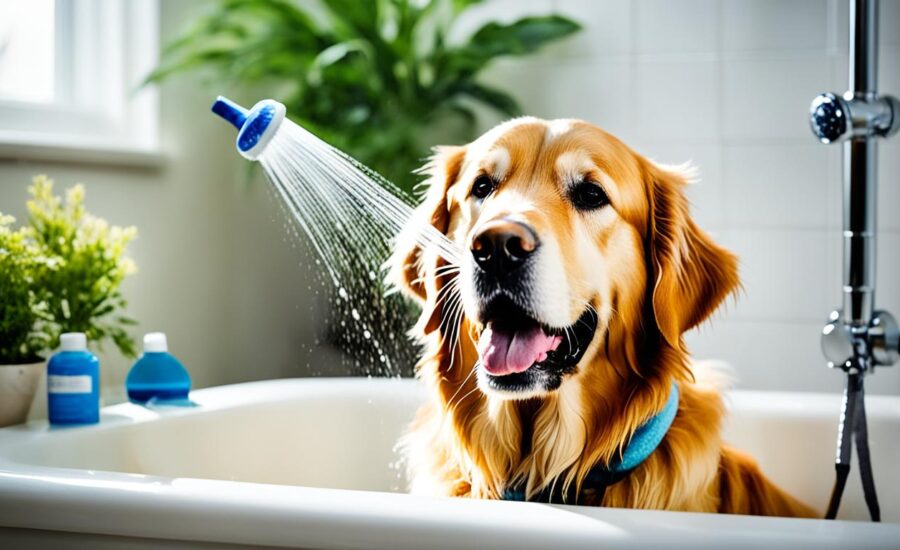DIY pet grooming is growing in popularity, but are you sure of the dos and don’ts for safety? It’s more than cutting hair; it’s about creating special moments. Moments that make your bond stronger and keep your pet safe. Grooming your pet is an art and science that turns a regular task into a special routine. This guide shows you how to groom your pet safely at home. You’ll learn everything from brushing to nail trimming, all to keep your pet clean and healthy.
Key Takeaways
- Understand the critical nature of DIY pet grooming safety for your pet’s well-being.
- Discover essential pet grooming tips that blend comfort with hygiene.
- Learn how to groom your pet through a steady, compassionate approach.
- Identify how regular grooming can double as a health inspection routine.
- Acquire the knowledge of picking the right tools and products for your pet’s grooming needs.
- Create a grooming space that prioritizes your pet’s comfort and security.
- Recognize the importance of building a trusting grooming routine step by step.
Understanding the Basics of Pet Grooming at Home
Embracing pet grooming at home is more than just keeping your pet looking good. It’s key for their health and happiness. You don’t need to be a pro to start. With some basics and patience, grooming can be fun for you and your pet.
Why Regular Grooming is Essential for Your Pet’s Health
Grooming is more than just a clean coat; it’s vital for your pet’s health. Regular grooming spots and treats problems like allergies or pests early on. Catching health issues early keeps your pet happy, active, and healthy.
Choosing the Right Shampoo and Grooming Products
Choosing the right grooming products is crucial. Pets need shampoos made for their skin type to prevent irritation. Adding conditioners, detanglers, and treatments helps each coat look its best.
Creating a Comfortable Grooming Environment
A calm and safe space is important for grooming. Use a non-slip mat and ensure there’s plenty of light. Keeping your pet relaxed makes grooming easier for both of you. Being consistent with the place and routine makes grooming a positive experience for your pet.
Paying attention to detail and having the right tools makes pet grooming at home successful. As you get better at grooming, it not only helps your pet but also brings you closer together.
DIY Pet Grooming: Dos and Don’ts
Starting DIY pet grooming can bring you closer to your pet. But, be careful to keep it safe. Let’s look into key steps to avoid pet grooming mistakes and make grooming fun for both.

Grooming involves many steps which can be daunting. Following the dos and don’ts of pet grooming is vital. Here are tips for a safe and enjoyable grooming experience.
- Do: Use shampoos made for pets to protect their skin.
- Do: Pick a grooming area that’s safe and cozy to reduce accidents or discomfort for your pet.
- Do: Get help when using risky tools like electric clippers or scissors.
- Do: Check your pet’s paw pads, ears, and teeth often for their well-being and happiness.
There are also important don’ts to keep your pet healthy during grooming:
- Don’t: Try to do all grooming at once; it can stress out your pet.
- Don’t: Skip cleaning sensitive spots like the eyes, ears, and anal glands.
- Don’t: Use human scents as they might bother your pet’s skin.
- Don’t: Forget to care for grooming tools; they should be sharp and clean.
The dos and don’ts are key for a peaceful grooming routine. Keeping your pet safe and comfy is as crucial as making them look good. Below is a detailed table on DIY pet grooming safety to confidently groom your pet at home.
| Aspect of Grooming | Do | Don’t |
|---|---|---|
| Shampoo Selection | Use pet-specific shampoos | Apply human shampoos or soaps |
| Grooming Area | Choose a non-slip, comfortable space | Groom in a cluttered or hazardous location |
| Tool Use | Have assistance and use care with sharp tools | Use dull or dirty tools |
| Cleaning Sensitive Areas | Be gentle around eyes and ears | Force cleaning if your pet is resistant |
By sticking to these dos and don’ts and steering clear of pet grooming mistakes, your pet stays safe. It makes grooming a happy part of your life together.
Step-by-Step Pet Grooming Techniques
Learning the best pet grooming techniques makes caring for your pet fun and easy. By adding top pet grooming tips to your daily routine, you’ll quickly learn how to groom your pet smoothly.
Brushing: Techniques and Tools for Every Coat Type
Every dog’s coat needs different care. For short-haired breeds, smooth brushing works best. But, long-haired pets need daily detangling. Use slicker brushes and undercoat rakes to keep your pet’s fur smooth. These tools help reduce shedding and stop matting.
Bathing: How to Make It a Stress-Free Experience
Make bath time calm for your pet by setting up a quiet wash area. Use non-slip mats and warm water. Pick dog-specific shampoos for a soft wash. Make sure to rinse well to prevent skin problems. A gentle touch and praise can make bath time fun.
Nail Trimming: Guidance for Safe Clipping
Keeping your pet’s nails short is key for healthy paws. Use the right clippers or grinders and be gentle. Trim little by little to avoid cutting too deep. Learn what your pet can handle and reward them with treats or play after.
Ear and Eye Care: Preventing Infections and Irritations
It’s critical to keep your pet’s ears clean and dry to stop infections. Gently wiping around their eyes removes debris. Adding these steps to your grooming routine protects your pet’s health. It keeps them alert and happy.
Grooming Your Pet Like a Pro: Tips for a Successful Session
Grooming your pet at home takes more than just tools. It’s about technique, understanding your pet, and being patient. When grooming, it’s essential to make your pet feel safe and relaxed. This makes the whole experience better for both of you.
Keeping Your Pet Calm During Grooming
Creating a calm space is key during grooming. Choose a quiet area that your pet knows well. Use gentle pets and treats to make grooming a positive experience. Being patient and kind helps your pet stay relaxed.

Dealing with Difficult Areas: Matted Hair and Sensitive Spots
Matted fur can be a problem for cats and dogs. Use mat splitters or detangling sprays, not force, to handle knots. Be extra gentle with sensitive areas, using the right tools. This keeps grooming positive and maintains your pet’s trust.
Maintaining Your Grooming Tools for Peak Performance
Tool maintenance is crucial for a pro groomer. Clean your tools after every use to avoid fur and dirt buildup. Check for wear and keep clippers and blades in top condition. For nail grinders, ensure they are sharp and fully charged. Proper tool care makes grooming smooth and less stressful for your pet.
By following these tips for pet grooming at home, you and your pet will enjoy grooming sessions more. It’s all about creating a positive experience for your furry friend.
Conclusion
Diving into DIY pet grooming is more than just making your pet look good. It’s about understanding their behavior and what they need. When you use the right pet grooming techniques, you make sure your pet is comfy. Every time you brush or trim their nails, you’re not just cleaning them. You’re also making your bond with them stronger.
We’ve looked at many pet grooming tips in this guide. These tips can help you do a great job grooming your pet. You’ve learned about choosing the best shampoo and how to keep your pet calm. It’s all about the mix of knowing what to do, being patient, and loving your pet. This makes grooming time special. It’s a chance to grow closer and build trust.
Lastly, grooming your pet at home does more than just make them look nice. It helps stop health problems before they start. It gets your pet used to being taken care of regularly. Most of all, it makes a caring space for your pet to be happy in. Getting good at grooming your pet at home shows how much you care about them.
FAQ
What are the safety essentials for DIY pet grooming at home?
What are some important pet grooming tips to remember?
How often should I groom my pet?
Why is regular grooming essential for a pet’s health?
How do I choose the right shampoo for my pet?
What should I consider when creating a grooming environment at home?
Can you list some dos and don’ts for DIY pet grooming?
What are the proper techniques for brushing a pet’s coat?
How can I make bathing my pet a stress-free experience?
What are some tips for safely trimming my pet’s nails?
How can I prevent infections and irritation in my pet’s ears and eyes?
How can I keep my pet calm during grooming sessions?
How should I deal with sensitive spots and matted hair?
What is the best way to maintain my grooming tools?
Are there any common pet grooming mistakes to avoid?
Source Links
- https://www.pedigree.in/puppy/diy-dog-grooming-a-comprehensive-list-of-dos-and-donts
- https://www.sidewalkdog.com/diy-dog-grooming-guide/
- https://www.reddit.com/r/doggrooming/comments/irmtyf/client_dos_and_donts_the_complete_guide/

